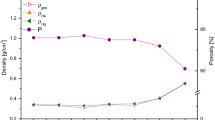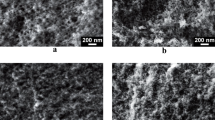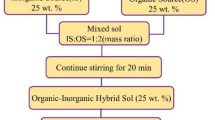Abstract
In the past two decades, resorcinol–formaldehyde (RF) gels have found widespread applications owing to their low density and adjustable pore size. They are usually prepared through sol–gel polymerization of the monomers in an aqueous media followed by evaporative or supercritical drying. In this study, RF gels were synthesized via sol–gel polymerization in the presence of sodium dodecylbenzene sulfonate (NaDBS) followed by ambient and supercritical drying. Dimensional measurements along with N2 sorption analysis and Scanning electron microscopy (SEM) micrographs revealed that pore structure of the gel is chiefly affected by NaDBS. In all samples (xerogels and aerogels), maximum densities were observed at a critical NaDBS concentration (~1 w/v%), whereas considerable pore size increments and pore size distribution broadenings were found at higher concentrations of NaDBS (≥5 w/v%). The most increased mesopore volumes were detected in xerogels (133% for acetone-dried and 67% for water-dried samples), while concerning aerogels, the pore sizes enlargement to macropore regime was observed at 5 w/v% of NaDBS. SEM micrographs, in agreement with porosity analysis, depicted that very large pore volumes could be obtained when supercritical drying was employed. However, in the case of xerogels, a more dense structure with smaller pores (micro and mesopores) exists which can only be altered slightly when using large amounts of NaDBS. The results showed that the RF gel pore texture, independent of drying technique, was strongly influenced by the addition of NaDBS, which should be taken into account when using this surfactant in the gel formulation for a wide variety of applications.








Similar content being viewed by others
References
Pekala RW (1989) Organic aerogels from the polycondensation of resorcinol with formaldehyde. J Mater Sci 24:3221–3227
Pierre AC, Pajonk GM (2002) Chemistry of aerogels and their applications. Chem Rev 102:4243–4265
Lu X, Arduini-Schuster MC, Kuhn J, Nilsson O, Fricke J, Pekala RW (1992) Thermal conductivity of monolithic organic aerogels. Science 255:971–972
Lu X, Caps R, Fricke J, Alviso CT, Pekala RW (1995) Correlation between structure and thermal conductivity of organic aerogels. J Non-Cryst Solids 188:226–234
Wiener M, Reichenauer G, Braxmeier S, Hemberger F, Ebert H-P (2009) Carbon aerogel-based high-temperature thermal insulation. Int J Thermophys 30:1372–1385
Kim SJ, Hwang SW, Hyun SH (2005) Preparation of carbon aerogel electrodes for supercapacitor and their electrochemical characteristics. J Mater Sci 40:725–731
Lin C, Ritter JA (1997) Effect of synthesis pH on the structure of carbon xerogels. Carbon 35:1271–1278
Job N, Pirard R, Marien J, Pirard J-P (2004) Porous carbon xerogels with texture tailored by pH control during sol–gel process. Carbon 42:619–628
Job N, Théry A, Pirard R, Marien J, Kocon L, Rouzaud J-N, Béguin F, Pirard J-P (2005) Carbon aerogels, cryogels and xerogels: influence of the drying method on the textural properties of porous carbon materials. Carbon 43:2481–2494
Tamon H, Ishizaka H (1999) Preparation of organic mesoporous gel by supercritical/freeze drying. Dry Technol 17:1653–1665
Job N, Panariello F, Marien J, Crine M, Pirard J-P, Léonard A (2006) Synthesis optimization of organic xerogels produced from convective air-drying of resorcinol–formaldehyde gels. J Non-Cryst Solids 352:24–34
Wu D, Fu R, Dresselhaus MS, Dresselhaus G (2006) Fabrication and nano-structure control of carbon aerogels via a microemulsion-templated sol–gel polymerization method. Carbon 44:675–681
Lee KT, Oh SM (2002) Novel synthesis of porous carbons with tunable pore size by surfactant-templated sol–gel process and carbonization. Chem Commun 22:2722–2723
Wu D, Fu R (2008) Requirements of organic gels for a successful ambient pressure drying preparation of carbon aerogels. J Porous Mater 15:29–34
Nishiyama N, Zheng T, Yamane Y, Egashira Y, Ueyama K (2005) Microporous carbons prepared from cationic surfactant–resorcinol/formaldehyde composites. Carbon 43:269–274
Bruno MM, Cotella NG, Miras MC, Koch T, Seidler S, Barbero C (2010) Characterization of monolithic porous carbon prepared from resorcinol/formaldehyde gels with cationic surfactant. Colloid Surf A 358:13–20
Matos I, Fernandes S, Guerreiro L, Barata S, Ramos AM, Vital J, Fonseca IM (2006) The effect of surfactants on the porosity of carbon xerogels. Micropor Mesopor Mat 92:38–46
Worsley MA, Satcher JH Jr, Baumann TF (2009) Enhanced thermal transport in carbon aerogel nanocomposites containing double-walled carbon nanotubes. J Appl Phys 105:1–5
Worsley MA, Satcher JH Jr, Baumann TF (2010) Influence of sodium dodecylbenzene sulfonate on the structure and properties of carbon aerogels. J Non-Cryst Solids 365:172–174
Wiener M, Reichenauer G, Scherb T, Fricke J (2004) Accelerating the synthesis of carbon aerogel precursors. J Non-Cryst Solids 350:126–130
Barrett EP, Joyner LG, Halenda PP (1951) The determination of pore volume and area distributions in porous substances. I. Computations from nitrogen isotherms. J Am Chem Soc 73:373–380
Brunauer S, Emmett PH, Teller E (1938) Adsorption of gases in multimolecular layers. J Am Chem Soc 60:309–319
Kraiwattanawong K, Tamon H, Praserthdam P (2011) Influence of solvent species used in solvent exchange for preparation of mesoporous carbon xerogels from resorcinol and formaldehyde via subcritical drying. Micropor Mesopor Mat 138:8–16
Heinrich T, Klett U, Fricke J (1995) Aerogels-nanoporous materials part I: sol-gel process and drying of gels. J Porous Mat 1:7–17
Sing KSW, Everett DH, Haul RAW, Moscou L, Pierotti RA, Rouquerol J, Siemieniewska T (1985) Reporting physisorption data for gas/solid systems with special reference to the determination of surface area and porosity. Pure Appl Chem 57:603–619
Pekala RW, Schaefer DW (1993) Structure of organic aerogels. 1 Morphology and scaling. Macromolecules 26:5487–5493
Zana R (2005) Dynamics of surfactant self-assemblies: micelles, microemulsions, vesicles, and lyotropic phases. CRC, FL, USA
Israelachvili JN (1985) Intermolecular and surface forces. Academic, London, Ch 1
Job N, Gommes CJ, Pirard R, Pirard J-P (2008) Effect of the counter-ion of the basification agent on the pore texture of organic and carbon xerogels. J Non-Cryst Solids 354:4698–4701
Acknowledgments
The first author would like to thank Dr. N. Job for her helpful discussions. The authors are also grateful to Mrs F. Ferri for her contribution in carrying out the experiments.
Author information
Authors and Affiliations
Corresponding author
Rights and permissions
About this article
Cite this article
Haghgoo, M., Yousefi, A.A. & Zohuriaan Mehr, M.J. Nano porous structure of resorcinol–formaldehyde xerogels and aerogels: effect of sodium dodecylbenzene sulfonate. Iran Polym J 21, 211–219 (2012). https://doi.org/10.1007/s13726-012-0023-4
Received:
Accepted:
Published:
Issue Date:
DOI: https://doi.org/10.1007/s13726-012-0023-4




